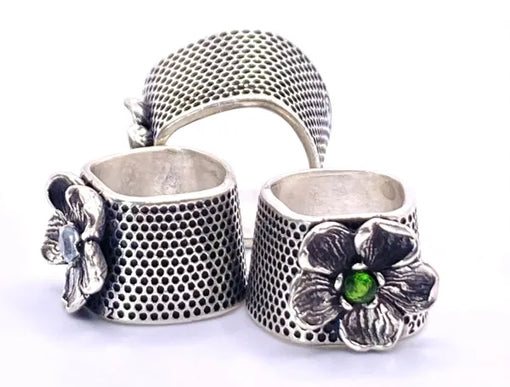
- Article published at:
- Article author: Jan Larson
For individuals interested in creating their distinctive clothing, practicing sewing is one of the many great pleasures available to enthusiasts.
In an era where mass production and fast fashion are on the rise, aficionados who prefer creating unique ensembles are reviving the craft of hand-sewing clothing with basic tools like a traditional sewing thimble.
A thimble should seem like a natural extension of your hand and may even become a priceless sewing accessory for creating fashionable clothing by hand.
What is a Traditional Sewing Thimble
When hand sewing, it’s a good idea to use a thimble to guard your fingertips from bruising and needle-prick injuries.
Thimbles are worn on the finger to push the needle through the fabric. Most thimbles are made of metal, yet historically there were also leather caps that were fitted over your fingertip like a tiny cup. The roots of the words “thimble” and “thumb” are similar, and in fact many quilters wear a thumble on the thumb for quilting in the opposite direction.
History of Traditional Sewing Thimbles
Over 30,000 years ago, mammoth hunters sewed pearls onto pieces of leather using the earliest known thimbles. The first thimble as we know it today was created in England by a Dutch metalworker around 1695. Being worn on the thumb and having a bell-like shape at the time led to the term “thumb-bell” being used to describe it.
Thimbles were formerly used to shield the finger while it pressed a needle into leather or fabric. Since then, they have developed new myths and applications. Thimbles were employed in the 1800s to measure alcoholic beverages.
These were also used by women of the night to tap on a window or door to let someone know they were there. Thimble-knocking also describes the tactic used by Victorian schoolmistresses to discipline disruptive students by tapping their heads with thimbles.
After the 18th century, tools for making thimbles were developed. The metal’s thickness and shape changed because they were no longer manufactured by hand. Early thimbles frequently have a prominent dome on top and are extremely thick. The top of later thimbles is flatter and narrower.
Typically, traditional sewing thimbles are constructed of porcelain, glass, leather, or rubber. Early thimbles were occasionally crafted from ivory, horn, or whale bone. A few hundred years ago, it was typical for thimble artisans to embellish their creations with semi-precious stones to decorate the rim.
Many thimbles were manufactured of silver during the 19th century. But because silver is such a soft metal, a steel needle might readily pierce it. A hardening process is now used to make the silver metal 78% stronger than the old ‘dead soft’ silver that came straight from casting.
Today’s thimbles are often constructed of silicone, rubber or metal and shield sewers from tweezers and sharp needles. The traditional sewing thimbles made at Thimbles for You are heirloom quality hardened 925 solid sterling silver.
How to Choose a Thimble
Thimbles come in several varieties and are employed for various tasks. Here are some key points to note before you purchase one:
Ensure it Fits
Most thimbles are worn on your dominant hand’s middle finger. Choose a thimble that is the right size—not too tight or loose. Place it on the middle finger of your sewing hand to see if it fits both the shape and size of your finger. Your fingertip should touch the metal end of the thimble. Now, move your fingers while hanging your hand at your side. You’ve found a strong contender if it stays on and doesn’t seem tight.
Pick a Style You Fancy
Depending on your comfort, pick a material that suits your requirements. You could pick one made of leather with a protective metal cap fitted inside, a plastic thimble, or one made of metal like the sterling silver traditional sewing thimbles we make. You are looking for a thimble that feels like part of your hand, yet it is a helmet to protect you from harm.
Purchase the Best Traditional Sewing Thimbles
At Thimbles For You, Jan Marie Larson crafts heirloom-quality, durable sterling silver thimbles that can be used for all kinds of hand-sewing requirements. Purchase yours today!
Learn More




